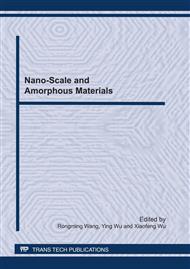p.326
p.334
p.339
p.344
p.349
p.353
p.358
p.364
p.370
A Facile Preparation of Carbon-Supported Nanoscale Zero-Valent Iron Fibers
Abstract:
In this paper, ferric alginate fibers was prepared by wet spinning of sodium alginate into a coagulating bath containing ferric chloride. The carbon-supported nanoscale zero-valent iron fibers (CSNZVIF) were obtained through thermal degradation of ferric alginate fiber at 900°Cunder N2 atmosphere. The product was characterized by field emission scanning electron microscopy (FESEM), X-ray power diffractometer (XRD), and Brunauer-Emmett-Teller (BET) surface area. It was found that zerovalent iron particles were well dispersed in the amorphous carbon fibers. CSNZVIF has high surface areas of 352 m2/g. The existence of carboxylic group and hydroxyl group in ferric alginate structure unit plays key role in the formation of carbon-supported nanoscale zero-valent iron fibers. Fe3+ was reduced to Fe0 by hydroxyl group and as-formed amorphous carbon during heating under N2. This thermal degradation and self-reduction reaction of ferric alginate fiber is potentially scalable to large production and continuous processing for preparing CSNZVIF.
Info:
Periodical:
Pages:
349-352
Citation:
Online since:
June 2011
Authors:
Price:
Сopyright:
© 2011 Trans Tech Publications Ltd. All Rights Reserved
Share:
Citation:


